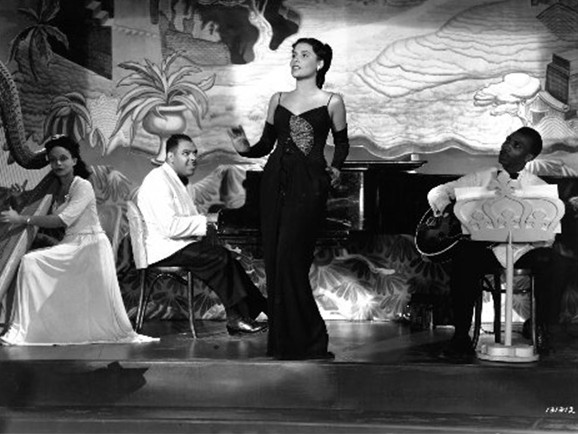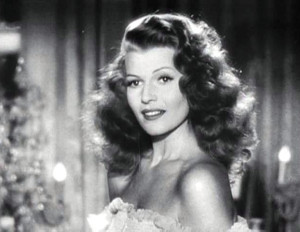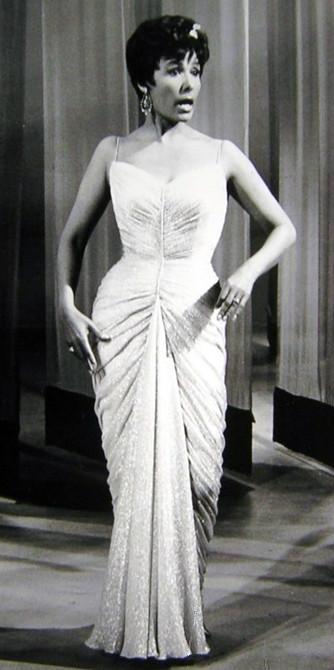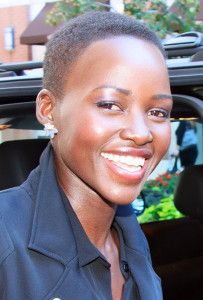By Marc Rivers
Rita Hayworth serenades a nightclub audience with the Latin-tinged love song “Amado Mio” in one of the most famous scenes in“Gilda.”
A spotlight caresses her body; the rhinestones on her pearly white dress twinkle like stars. The soft lighting makes her glow. The rest of the audience sits in shadow; all eyes on Gilda. As she dances, her silhouette teases the audience in Charles Vidor’s 1946 noir, now a special high-definition release in the Criterion Collection of classic and contemporary films.
Like many public spaces in 1946 America, this scene and this sort of role carried the label Whites Only. In Hollywood, black actresses like Lena Horne were denied the glamour and adoration lavished upon performers like Rita Hayworth. Though Hayworth and Horne were born just a year apart in Brooklyn, the women’s careers might as well have unfolded on two different planets, separate and unequal.
This planet in ‘46 also saw Ava Gardner in “The Killers” and Lana Turner in “The Postman Always Rings Twice.” These films belonged to a post-World War II fraternity dubbed Film Noir: Men with fedoras walked mean streets that seemed to snake out from their own troubled pasts.
And their women wore dresses whose necklines plunged almost as low as their morals, sometimes leading the men who fell for them to their doom.
Hayworth, Gardner and Turner flourished when movies never fell harder for their stars.
Black beauty on screen never got the same treatment. Lena Horne came closest to Rita Hayworth in musicals like 1943’s “Cabin in the Sky” and “Stormy Weather,” which had all-black casts. In integrated situations, movie studios would often shoot her scenes in such a way that they could be easily cut from the film when it played in the South to avoid offending racist white sensibilities.
Dissatisfied with the roles offered to her, Horne spent much of the 1940s singing songs whose titles and lyrics echoed how Hollywood treated her. While Hayworth in 1946 lip-synced “Amado mio, love me forever” in “Gilda,” in 1947 Horne sang, “Nobody Knows the Trouble I’ve Seen” and “Sometimes I Feel Like a Motherless Child.”
Hollywood orphaned the careers of Horne, and Nina Mae McKinney and Fredi Washington before her, robbing them of what should’ve been their glamour years. In a New York Times obituary for Horne, who was born in 1917, the writer laments, “She might have become a major movie star, but she was born 50 years too early.”
Oh, really? Look at Halle Berry. Born in 1966, she won her Oscar for a wholly unglamorous turn in 2001’s “Monster’s Ball” and an Emmy for playing Dorothy Dandridge, incidentally another black goddess forced to waste away in white Hollywood. Despite playing a Bond girl in 2002’s “Die Another Day,” Esquire’s 2008 Sexiest Woman Alive has rarely been that on screen.
In 2016, there may not be any stars of Hayworth or Gardner wattage, but white beauty remains the standard. In an age of black beauties like Oscar winner Lupita Nyong’o, Gugu Mbatha-Raw and Nicole Beharie, this is shameful.
And too often, movie cameras grope black women rather than caress them. They are sex objects rather objects of affection.
But Lupita and other black actresses don’t deserve to be treated like Fetty Wap’s Trap Queen:
“Seen yo pretty ass soon as you came in that door.”
They deserve Smokey Robinson, and the sort of crush he expressed in his song “You Must Be Love”:
“You look as if you’re softer than a rosebud and you’re warmer than the sun that makes it grow.”
For more than 70 years — Lena to Lupita — beautiful black actresses have stood ready for their Hollywood close-ups. Now is the time.
Marc Rivers is the arts & entertainment critic for TruthBeTold.news. He is also producer and co-host of the TBT podcast.



